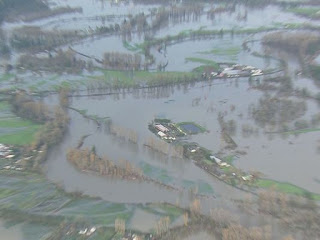Cliff Mass Weather Blog
November 19, 2015
How can we be in a drought if there is flooding?
According to our government, the entire state is in at least moderate drought, with NW Washington and eastern Washington being in severe or extreme drought.
The Drought-affected Snoqualmie Valley
THIS IS RIDICULOUS! There is absolutely no objective measure showing that western Washington is abnormally dry. And their changes do not recognize the HUGE amount of moisture that has fallen on the Cascades--on both sides. I found it hard to understand how NOAA (the National Weather Service) and other groups can allow such a subjective and obviously wrong measure to become the NATION'S MAIN DROUGHT INDEX. And let me assure you, I can point out equally problematic drought appraisals in other parts of the country.
The current official US Government Drought Monitor graphic for Washington State is shown below.
Our society needs to plan and make adaptations for upcoming climate change. Products like the Drought Monitor will hinder efforts to do so in a rational, robust fashion.
If it is evident that there is no drought, why is the Drought Monitor saying we are NOW in a serious drought? Read on..
First, it is ridiculous to claim that our entire state is in moderate or more severe drought. There are stronger words I could have used, but this is is a family friendly blog.
Many of our local RIVER ARE FLOODING with nearly all Washington rivers running above normal. For example, here is the latest USGS streamflow map. Nearly the entire state has streamflows that are well above normal (green, blue, and black), with some of the largest flows over the eastern slopes of the Cascades. The latest NW River Forecast Center summaries show many rivers in serious flood stage over our state from the Yakima River in eastern Washington, to the Snoqualmie, to the Chehalis, and more. Doesn't look like drought there.
Well, what about PRECIPITATION? Most of the state is above normal (greens and blues), including all of western Washington, the Cascades, including the eastern slopes, and most of far eastern Washington. And where it is low (Columbia Basin), it is only a bit below normal. And those folks generally get their water from the Columbia River, which is at normal levels.
How about the official CROP MOISTURE index? Way above normal in western WA and normal in the east.
I know what you are thinking, what about SNOWPACK? The U.S. Government SNOTEL sites range from 42 to 205% of normal. And many of our ski areas will be opening early for Thanksgiving (e.g., Baker, Whistler).
Many of our RESERVOIRS ARE WELL ABOVE NORMAL from recent rains. Take Seattle. Here is the total storage of the Tolt and Chester Morse reservoirs. Levels have jumped to WAY ABOVE normal and are about 80% full. No problems with having enough water for next summer at this rate.
Even reservoirs on the eastern slopes that feed the critical Yakima River are well above normal - and rising! (red asterisks). We are on track to completely fill the Yakima reservoirs earlier than normal.
It is silly to suggest that we are in a drought. We are not. And typical precipitation during even strong El Nino years is generally at or slightly below normal, so there is no reason to expect a drought ahead.
Now, I know what you are wondering. If it is evident that there is no drought, why is the Drought Monitor saying we are NOW in a serious drought?
Now we get to the embarrassing part of the blog. The Drought Monitor is produced through a partnership between the National Drought Mitigation Center at the University of Nebraska-Lincoln, the United States Department of Agriculture, and the National Oceanic and Atmospheric Administration.
And now the key point: it is a SUBJECTIVE, QUALITATIVE BLEND of all kinds of information, including subjective appraisals of impacts. It is not a strictly objective index based on precipitation, soil moisture, and the like. And the folks that make this index tend to seriously exaggerate drought, as should be obvious to anyone who read the early part of my blog. I will let you speculate why they are producing an unreliable product.
The Drought Monitor is unscientific, subjective and is doing the nation and our region a disservice by providing unreliable information that will lead authorities and governments to make the wrong decisions. It is also being used by some to hype the current impacts of climate change produced by anthropogenic greenhouse gases.
Our society needs to plan and make adaptations for upcoming climate change. Products like the Drought Monitor will hinder efforts to do so in a rational, robust fashion. It should be ended and replaced by a rational, completely objective product.






















No comments:
Post a Comment